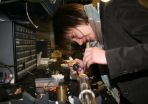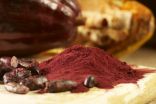A switch to dampen malignancy
Ludwig researchers describe how a tumor suppressor helps control changes in cell shape and motility that are central to metastasis
2014-10-26
(Press-News.org) October 26, 2014, New York, NY – Ludwig Oxford researchers have discovered a key mechanism that governs how cells of the epithelia, the soft lining of inner body cavities, shift between a rigid, highly structured and immobile state and a flexible and motile form. Published in the current issue of Nature Cell Biology, their study shows that a tumor suppressor protein named ASPP2 functions as a molecular switch that controls this process and its reverse, both of which play a critical role in a number of biological phenomena, including wound healing, embryonic development and, not least, the metastasis of cancers.
"We were trying to identify molecular switches that control the plasticity of epithelial cells," says Ludwig Oxford director Xin Lu, who led the study with Yajun Guo of The Second Military Medical University in Shanghai, China. "Such plasticity is a hallmark of cancer. In order to metastasize, a settled cancer cell must loosen its structure, wiggle free from its confines, travel to another part of the body and, once there, settle down to form a colony. Both processes, known as epithelial to mesenchymal transition and mesenchymal to epithelial transition (or, EMT and MET) are necessary for that to happen."
Lu and her team find that ASPP2 contributes to MET in the development and maintenance of kidney tubules, which filter waste out of the blood stream. Its absence, however, does not completely disrupt the process. Loss of ASPP2 expression dramatically promotes EMT, especially in cells that express a common cancer gene known as oncogenic RAS, which also drives metastasis.
Further, the researchers show in a mouse model that when breast cancer cells express low levels of ASPP2, they metastasize furiously to the brain; if those cells are forced to express the full ASPP2 protein, their ability to metastasize declines significantly. When they express only the portion of ASPP2 that drives MET, however, they actually metastasize a bit better than do the control cells. "This underscores the importance of MET in the final stages of a cancer cell's metastasis, when it establishes a new malignant colony," says Ludwig Oxford's Yihua Wang, co-lead author of the study.
An analysis of liver and breast tumors taken from patients reveals that the findings have clinical significance: poor ASPP2 expression in these cancers correlates with significantly lower patient survival.
Lu and her colleagues discovered that ASPP2 controls MET and EMT through its association with two proteins involved in establishing the junction between epithelial cells: E-cadherin and β-catenin.
It does so by anchoring β-catenin to the junction, both directly and by promoting its association with E-cadherin. This prevents β-catenin from zipping down to the nucleus, where it can fuel the expression of genes that drive EMT—and metastasis. Oncogenic RAS has the opposite effect, which is why cells lacking ASPP2 and expressing oncogenic RAS undergo EMT very efficiently.
"While we have learned a great deal about the drivers of EMT in recent years, much less is known about the inducer of the reverse process, MET, which is equally important to both healthy development and cancer metastasis," says Lu. "This study has identified a new inducer and a gatekeeper of MET."
INFORMATION:
The study was primarily supported by the Ludwig Institute for Cancer Research, with additional support from the National Natural Science Foundation of China and Medical Research Council (MRC) UK.
About Ludwig Cancer Research
Ludwig Cancer Research is an international collaborative network of acclaimed scientists with a 40-year legacy of pioneering cancer discoveries. Ludwig combines basic research with the ability to translate its discoveries and conduct clinical trials to accelerate the development of new cancer diagnostics and therapies. Since 1971, Ludwig has invested more than $2.5 billion in life-changing cancer research through the not-for-profit Ludwig Institute for Cancer Research and the six U.S.-based Ludwig Centers.
Xin Lu is Director of the Ludwig Institute for Cancer Research Oxford and a Professor of Cancer Biology at the University of Oxford's Nuffield Department of Clinical Medicine.
For further information please contact Rachel Steinhardt.
ELSE PRESS RELEASES FROM THIS DATE:
2014-10-26
PROVIDENCE, R.I. [Brown University] — Superconductors and magnetic fields do not usually get along. But a research team led by a Brown University physicist has produced new evidence for an exotic superconducting state, first predicted a half-century ago, that can indeed arise when a superconductor is exposed to a strong magnetic field.
"It took 50 years to show that this phenomenon indeed happens," said Vesna Mitrovic, associate professor of physics at Brown University, who led the work. "We have identified the microscopic nature of this exotic quantum state of ...
2014-10-26
Scientists have created cells with fluorescent dyes that change color in response to specific neurochemicals. By implanting these cells into living mammalian brains, they have shown how neurochemical signaling changes as a food reward drives learning, they report in Nature Methods online October 26.
These cells, called CNiFERs (pronounced "sniffers"), can detect small amounts of a neurotransmitter, either dopamine or norepinephrine, with fine resolution in both location and timing. Dopamine has long been of interest to neuroscientists for its role in learning, reward, ...
2014-10-26
Lasers – devices that deliver beams of highly organized light – are so deeply integrated into modern technology that their basic operations would seem well understood. CD players, medical diagnostics and military surveillance all depend on lasers.
Re-examining longstanding beliefs about the physics of these devices, Princeton engineers have now shown that carefully restricting the delivery of power to certain areas within a laser could boost its output by many orders of magnitude. The finding, published Oct. 26 in the journal Nature Photonics, could allow ...
2014-10-26
NEW YORK, NY (October 26, 2014)—Dietary cocoa flavanols—naturally occurring bioactives found in cocoa—reversed age-related memory decline in healthy older adults, according to a study led by Columbia University Medical Center (CUMC) scientists. The study, published today in the advance online issue of Nature Neuroscience, provides the first direct evidence that one component of age-related memory decline in humans is caused by changes in a specific region of the brain and that this form of memory decline can be improved by a dietary intervention.
As ...
2014-10-26
MOUNT WILSON, Calif.–Astronomers at Georgia State University's Center for High Angular Resolution Astronomy (CHARA) have observed the expanding thermonuclear fireball from a nova that erupted last year in the constellation Delphinus with unprecedented clarity.
The observations produced the first images of a nova during the early fireball stage and revealed how the structure of the ejected material evolves as the gas expands and cools. It appears the expansion is more complicated than simple models previously predicted, scientists said. The results of these observations, ...
2014-10-26
BOSTON –– Scientists say they have identified in about 20 percent of colorectal and endometrial cancers a genetic mutation that had been overlooked in recent large, comprehensive gene searches. With this discovery, the altered gene, called RNF43, now ranks as one of the most common mutations in the two cancer types.
Reporting in the October 26, 2014 edition of Nature Genetics, investigators from Dana-Farber Cancer Institute and the Broad Institute of MIT and Harvard said the mutated gene helps control an important cell-signaling pathway, Wnt, that has been ...
2014-10-26
Why do we remember some things and not others? In a unique imaging study, two Northwestern University researchers have discovered how neurons in the brain might allow some experiences to be remembered while others are forgotten. It turns out, if you want to remember something about your environment, you better involve your dendrites.
Using a high-resolution, one-of-a-kind microscope, Daniel A. Dombeck and Mark E. J. Sheffield peered into the brain of a living animal and saw exactly what was happening in individual neurons called place cells as the animal navigated a virtual ...
2014-10-26
Digoxin, a medication used in the treatment of heart failure, may be adaptable for the treatment of amyotrophic lateral sclerosis (ALS), a progressive, paralyzing disease, suggests new research at Washington University School of Medicine in St. Louis.
ALS, also known as Lou Gehrig's disease, destroys the nerve cells that control muscles. This leads to loss of mobility, difficulty breathing and swallowing and eventually death. Riluzole, the sole medication approved to treat the disease, has only marginal benefits in patients.
But in a new study conducted in cell cultures ...
2014-10-26
CHAMPAIGN, Ill. — Researchers report in the journal Nature that they have made a breakthrough in understanding how a powerful antibiotic agent is made in nature. Their discovery solves a decades-old mystery, and opens up new avenues of research into thousands of similar molecules, many of which are likely to be medically useful.
The team focused on a class of compounds that includes dozens with antibiotic properties. The most famous of these is nisin, a natural product in milk that can be synthesized in the lab and is added to foods as a preservative. Nisin has ...
2014-10-24
Most of the concerns about climate change have focused on the amount of greenhouse gases that have been released into the atmosphere.
But in a new study published in Science, a group of Rutgers researchers have found that circulation of the ocean plays an equally important role in regulating the earth's climate.
In their study, the researchers say the major cooling of Earth and continental ice build-up in the Northern Hemisphere 2.7 million years ago coincided with a shift in the circulation of the ocean – which pulls in heat and carbon dioxide in the Atlantic ...
LAST 30 PRESS RELEASES:
[Press-News.org] A switch to dampen malignancy
Ludwig researchers describe how a tumor suppressor helps control changes in cell shape and motility that are central to metastasis







